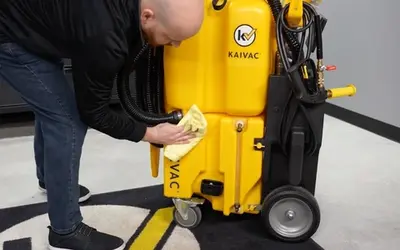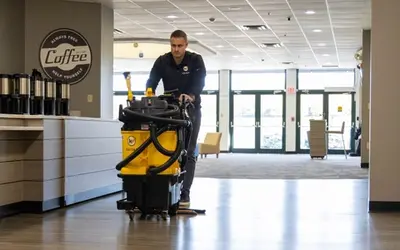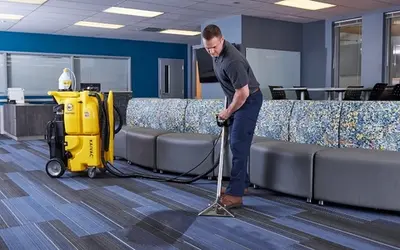Can You Clean with Water Only?

Can maintenance professionals effectively and safely clean with water only? The answer is a qualified yes. Plain tap water, combined with the right cleaning processes and tools, effectively removes soils and bacteria from surfaces.
Giving up cleaning products and using water alone offers lots of benefits. The ultimate example of sustainable cleaning, the practice saves money and resources while protecting workers from harsh chemicals.
But cleaning with water only is not appropriate for every surface, soil type, or situation. This blog can help you decide when to reach for chemicals and when water alone will do the trick.
Why Use Cleaning Chemicals at All?
Cleaning chemicals rightfully earned their place in your supply closet. These products contain surface active agents, also known as surfactants, to reduce the surface tension of water. Surfactants make water “wetter” allowing it to spread out and wet the surface of what you’re trying to clean.
Surfactants also cause water to form little spheres called micelles that attract and hold on to dirt, soils, and organic matter. Once trapped, the dirt particles easily rinse away. These properties make cleaning chemicals perfect for removing greasy, sticky, and heavy soils.
Your chemical cache probably also contains a few powerful choices for sanitizing or disinfecting. Don’t confuse the two. Sanitizers reduce the number of microorganisms on a surface while disinfectants kill them. These EPA-registered products might incorporate cleaning agents to clean and sanitize or disinfect in one step. However, the chemical’s main purpose is to kill or reduce dangerous pathogens.
When Should You Clean with Water Only?
First, let’s be clear. There are situations where cleaning with water is not appropriate. This article on the CleanLink website offers good insight on when to reach for the cleaning chemicals.
The piece stresses that fats, oils, and grease are easier to remove with help from chemicals. The same is true for anything sticky or syrupy. Ice melt also requires removal with an appropriate chemical. Without it, ice melt dissolves, spreads, and leaves a sticky, white residue. Potentially contaminated spaces, like a restroom, kitchen, or anywhere in a health care setting, also need cleaning chemicals.
But dust and light soils can be cleaned from floors and surfaces with water alone. This sustainable cleaning practice is appropriate for facilities that are maintained regularly.
The Benefits of Cleaning with Water Only
As mentioned above, cleaning with water only offers many benefits from saving money to improving indoor air quality. Even the Occupational Safety and Health Administration (OSHA) and the National Institute for Occupational Safety and Health (NIOSH) strongly urge using chemical-free cleaning systems to protect human health.
Some of the benefits of this green cleaning practice include:
- Money savings: Buying cleaning chemicals is getting more and more expensive. Moving to a water-only practice will help offset those costs.
- Completely sustainable: No greenwashing here. Cleaning with water leads better indoor air quality while generating less hazardous wastewater.
- Better for staff: Cleaning chemicals can cause eye, skin, and respiratory irritation even when properly diluted. In concentrated form, they can be even more dangerous. Using water only eliminates that risk.
- Completely effective: When used with the right tools, cleaning with water only removes 99.9% of targeted soils.
How to Clean with Water Only
Cleaning with water only requires the right tools and techniques to fully remove soils and pathogens. For countertops, desktops, and other flat surfaces consider the KaiFly™ from Kaivac. This tool combines microfiber with a squeegee to trap and remove soils and bio pollutants. In fact, tests conducted by an independent NELAP-accredited laboratory proved that KaiFly removed greater than 99.9% of targeted bacteria from surfaces when used with plain tap water only.
For floors Kaivac offers the AutoVac Stretch™ and UniVac™. Both have Green Seal® certification for Environmental Innovation.
Perfect for wide-area, hard surface floors, the AutoVac Stretch performs as well or better than autoscrubbers while using less water and taking time. If cleaning chemical is needed, the AutoVac Stretch has an innovative double filter system that allows the recycling of cleaning solution without impacting results.
The UniVac is perfect for cleaning tile floors with water alone. The technology works much faster than manual mopping and leaves floors 60 times cleaner.
Cleaning with water alone is a great option for professionals looking to green their maintenance practice. Check out other great green options from Kaivac here.
Related Posts

Preventive Maintenance for Your No-Touch Cleaning® System
Your Kaivac No-Touch Cleaning system makes restroom maintenance fast and easy. Keeping your No-Touch Cleaning system in good working order is also fast and easy. Kaivac makes performing preventative maintenance and troubleshooting potential issues simple. No special equipment or technical expertise required.
Read more
How to Clean Worship Facility Floors
Worship facilities need clean, safe floors to best serve their congregations. Here’s how tools from Kaivac keep worship facilities clean from the entry to seating areas to kitchens and more.
Read more
Accessories Let Your Kaivac Do More
You love the way your Kaivac machine cleans. But did you know your Kaivac can do even more? Accessories allow your cleaning staff to reach higher, clean deeper, and cover more ground with the same Kaivac machine they use every day.
Read more